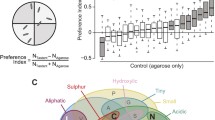Abstract
Electrophysiological recordings from taste sensilla of the caterpillar Estigmene acrea with the pyrrolizidine alkaloid, seneciphylline N-oxide, demonstrated that prior feeding on plants with pyrrolizidine alkaloids caused an increase in responsiveness of the PA-sensitive cells in two sensilla, relative to feeding on plants without such chemicals. Rearing on synthetic diet without pyrrolizidine alkaloids for up to seven generations caused a continuous decline in responsiveness, that could be reversed by experience with powdered Crotalaria pumila in the diet or by pure pyrrolizidine alkaloid, monocrotaline, in the diet. Response to the cardiac glycoside, ouabain, that stimulates one of the two pyrrolizidine alkaloid-sensitive cells, showed a similar decline. Pyrrolizidine alkaloids had no measurable effect on growth and development. Responses in all other taste cells were unaffected. The data are discussed in relation to the possible adaptive significance and the possible mechanisms involved.








Similar content being viewed by others
References
Bernays EA (2001) Neural limitations in phytophagous insects: implications for diet breadth and evolution of host affiliation. Annu Rev Entomol 46:703–727
Bernays EA, Weiss EA (1996) Induced food preferences in caterpillars: the need to identify mechanisms. Entomol Exp Appl 78:1–8
Bernays EA, Chapman RF, Hartmann T (2002a) A highly sensitive taste receptor cell for pyrrolizidine alkaloids in the lateral galeal sensillum of a polyphagous caterpillar, Estigmene acrea. J Comp Physiol A188:715–723
Bernays EA, Chapman RF, Hartmann T (2002b) A taste receptor neurone dedicated to the perception of pyrrolizidine alkaloids in the medial galeal sensillum of two polyphagous arctiid caterpillars. Physiol Entomol 27:312–321
Bernays EA, Rodriquez D, Chapman RF, Singer MS, Hartman T (2003) Loss of gustatory responses to pyrrolizidine alkaloids after extensive ingestion of them in the polyphagous caterpillar, Estigmene acrea. J Exp Biol (in press)
Blaney WM, Schoonhoven LM, Simmonds MSJ (1986) Responsiveness variations in insect chemoreceptors: a review. Experientia 42:13–19
Cagan RH (1979) Biochemical studies of taste sensation. VII. Enhancement of taste stimulus binding to a catfish taste receptor preparation by prior exposure to the stimulus. J Neurobiol 10:207–220
Campo ML del, Miles CI, Schroeder FC, Mueller C, Booker R, Renwick JA (2001) Host recognition by the tobacco hornworm is mediated by a host plant compound. Nature 411:186–189
De Boer G (1993) Plasticity in food preference and diet-induced differential weighting of chemosensory information in larval Manduca sexta. J Insect Physiol 39:17–24
Frazier JL, Hanson FE (1986) Electrophysiological recording and analysis of insect chemosensory responses. In: Miller TA, Miller J (eds) Insect-plant interactions. Springer, Berlin Heidelberg New York, pp 285–330
Glendinning JI, Ensslen S, Eisenberg ME, Weiskopf P (1999) Diet-induced plasticity in the taste system of an insect: localization to a single transduction pathway in an identified taste cell. J Exp Biol 202:2091–2102
Glendinning JI, Brown H, Capoor M, Davis A, Gbedemah A, Long E (2001) A peripheral mechanism of behavioral adaptation to specific “bitter” taste stimuli in an insect. J Neurosci 21:3688–3696
Gothilf S, Hanson FE (1994) A technique for electrophysiologically recording from chemosensory organs of intact caterpillars. Entomol Exp Appl 72:305–310
Hartmann T, Witte L (1995) Pyrrolizidine alkaloids: chemical, biological and chemoecological aspects. In: Pelletier SW (ed) Alkaloids: chemical and biological perspectives, vol 9. Pergamon Press, Oxford, pp 155–233
Hodgson ES, Lettvin JY, Roeder KD (1955) Physiology of a primary chemoreceptor unit. Science 122:417–418
Krasnoff SB, Roelofs WL (1989) Quantitative and qualitative effects of larval diet on male scent secretions of Estigmene acrea, Phragmatobia fuliginosa, and Pyrrharctia isabella (Lepidoptera: Arctiidae). J Chem Ecol 15:1077–1093
Renwick JAA (2001) Variable diets and changing taste in insect-plant relationships. J Chem Ecol 27:1063–1076
Rothschild M, Aplin RT, Cockrum PA, Edgar JA, Fairweather P, Lees R (1979) Pyrrolizidine alkaloids in arctiid moths (Lep.) with a discussion on host plant relationships and the role of these secondary plant substances in the Arctiidae. Biol J Linn Soc 12:305–326
Schoonhoven LM (1969) Responsiveness changes in some insect chemoreceptors and their effect on food selection behaviour. Proc K Ned Akad Wet 72:491–498
Schoonhoven LM, Jermy T, Loon JJA van (1998) Insect-plant biology. Chapman & Hall, London
Simpson SJ, Simpson CL (1992) Mechanisms controlling modulation by haemolymph amino acids of gustatory responsiveness in the locust. J Exp Biol 168:269–287
Smith JJB, Mitchell BK, Rolseth BM, Whitehead AT, Albert PJ (1990) SAPID tools: microcomputer programs for analysis of multi-unit nerve recordings. Chem Senses 15:253–270
Weller SJ, Jacobson NL, Conner WE (1999) The evolution of chemical defenses and mating systems in tiger moths (Lepidoptera: Arctiidae). Biol J Linn Soc 68:557–578
Yamamoto RT (1969) Mass rearing of the tobacco hornworm. II. Larval rearing and pupation. J Econ Entomol 62:1427–1431
Acknowledgements
M.S.S. was funded by NIH Institutional Research and Academic Career Development Award, PAR-98–085 to the Center for Insect Science. Dr Erich Städler made the STA program available to us, Dr John O. Stireman gave us the eggs from Louisiana.
Author information
Authors and Affiliations
Corresponding author
Additional information
R.F. Chapman has died since this article was written
Rights and permissions
About this article
Cite this article
Chapman, R.F., Bernays, E.A., Singer, M.S. et al. Experience influences gustatory responsiveness to pyrrolizidine alkaloids in the polyphagous caterpillar, Estigmene acrea . J Comp Physiol A 189, 833–841 (2003). https://doi.org/10.1007/s00359-003-0461-8
Received:
Revised:
Accepted:
Published:
Issue Date:
DOI: https://doi.org/10.1007/s00359-003-0461-8




